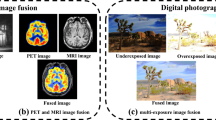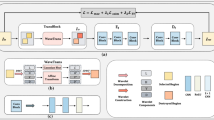Abstract
This paper investigates challenging fully unsupervised defogging problems, i.e., how to remove fog by feeding only foggy images in deep neural networks rather than using paired or unpaired synthetic images, and how to overcome the problems of insufficient structure and detail recovery in existing unsupervised defogging methods. For this purpose, a zero-reference image defogging method (ZRDNet) is proposed to solve these two problems. Specifically, we develop an unsupervised defogging network consisting of a layer decomposition network and a perceptual fusion network, which are separately optimized by joint multiple-loss based on the stage-wise learning. The decomposition network guides the image decomposition–reconstruction process by rationally constructing loss functions. The fusion network further enhances the details and contrast of the defogged images by fusing the decomposition–reconstruction results. The joint multiple-loss optimization strategy based on the stage-wise learning guides decomposition and fusion tasks, which are completed stage-by-stage. Additionally, a non-reference loss is constructed to prevent artifacts and distortion induced by transmission value deviation. Our method is completely unsupervised, and training only relies on fog images and information derived from the fog images themselves. Experiments are conducted to demonstrate that our ZRDNet, which overcomes the problems of insufficient structure and detail recovery, and domain shift induced by using synthetic image, achieves favorable performance.








Similar content being viewed by others
Explore related subjects
Discover the latest articles, news and stories from top researchers in related subjects.Data availability
The datasets generated during and/or analyzed during the current study are available from the corresponding author on reasonable request.
References
Kuanar, S., Mahapatra, D., Bilas, M., et al.: Multi-path dilated convolution network for haze and glow removal in nighttime images. Vis. Comput. 38, 1121–1134 (2022)
Narasimhan, S.G., Nayar, S.K.: Contrast restoration of weather degraded images. IEEE Trans. Pattern Anal. Mach. Intell. 25(6), 713–724 (2003)
He, K., Sun, J., Tang, X.: Single image haze removal using dark channel prior. IEEE Trans. Pattern Anal. Mach. Intell. 33(12), 2341–2353 (2011)
Bui, T.M., Kim, W.: Single image dehazing using color ellipsoid prior. IEEE Trans. Image Process. 27(2), 999–1009 (2018)
Zhang, X., Wang, T., Tang, G., et al.: Single image haze removal based on a simple additive model with haze smoothness prior. IEEE Trans. Circuits Syst. Video Technol. 32(6), 3490–3499 (2022)
Zhu, Q., Mai, J., Shao, L.: A fast single image haze removal algorithm using color attenuation prior. IEEE Trans. Image Process. 24(11), 3522–3533 (2015)
Zhang, S., Zhang, J., He, F., et al.: DRDDN: dense residual and dilated dehazing network. Vis. Comput. 39(3), 953–969 (2023)
Yi, W., Dong, L., Liu, M., et al.: MFAF-Net: image dehazing with multi-level features and adaptive fusion. Vis. Comput. (2023). https://doi.org/10.1007/s00371-023-02917-8
Song, Y., He, Z., Qian, H., et al.: Vision transformers for single image dehazing. IEEE Trans. Image Process. 32, 1927–1941 (2023)
Yang, D., Sun, J.: Proximal dehaze-net: a prior learning-based deep network for single image dehazing. In: European Conference on Computer Vision, Munich, Germany, pp. 702–717 (2018)
Qin, X., Wang, Z., Bai, Y., et al: FFA-Net: feature fusion attention network for single image dehazing. In: AAAI Conference on Artificial Intelligence, New York, USA, pp. 11908–11915 (2020)
Chen, Z., Wang, Y., Yang, Y., et al.: PSD: principled synthetic-to-real dehazing guided by physical priors. In: IEEE Conference on Computer Vision and Pattern Recognition, Nashville, USA, pp. 7176–7185 (2021)
Yang, F., Zhang, Q.: Depth aware image dehazing. Vis. Comput. 38(5), 1579–1587 (2022)
Li, X., Hua, Z., Li, J.: Attention-based adaptive feature selection for multi-stage image dehazing. Vis. Comput. 39(2), 663–678 (2023)
Engin, D., Genc, A., Ekenel, H.K.: Cycle-Dehaze: enhanced CycleGAN for single image dehazing. In: IEEE Conference on Computer Vision and Pattern Recognition Workshops, Salt Lake City, USA, pp. 938–9388 (2018)
Yang, X., Xu, Z., Luo, J.: Towards perceptual image dehazing by physics-based disentanglement and adversarial training. In: AAAI Conference on Artificial Intelligence, New Orleans, USA, pp. 7485–7492 (2018)
Wang, S., Mei, X., Kang, P., et al.: DFC-dehaze: an improved cycle-consistent generative adversarial network for unpaired image dehazing. Vis. Comput. (2023). https://doi.org/10.1007/s00371-023-02987-8
Li, L., Dong, Y.L., Ren, W.Q., et al.: Semi-supervised image dehazing. IEEE Trans. Image Process. 29, 2766–2779 (2020)
Zhao, S., Zhang, L., Shen, Y., et al.: RefineDNet: a weakly supervised refinement framework for single image dehazing. IEEE Trans. Image Process. 30, 3391–3404 (2021)
Yang, Y., Wang, C., Liu, R., et al.: Self-augmented unpaired image dehazing via density and depth decomposition. In: IEEE Conference on Computer Vision and Pattern Recognition, New Orleans, USA, pp. 2037–2046 (2022)
Goodfellow, I., Pouget-Abadie, J., Mirza, M., et al.: Generative adversarial nets. In: Advances in Neural Information Processing Systems, Montreal, Canada, pp. 2672–2680 (2014)
Jiang, Q., Mao, Y., Cong, R., et al.: Unsupervised decomposition and correction network for low-light image enhancement. IEEE Trans. Intell. Transp. Syst. 23(10), 19440–19455 (2022)
Guo, C., Li, C., Guo, J., et al.: Zero-reference deep curve estimation for low-light image enhancement. In: IEEE Conference on Computer Vision and Pattern Recognition, Seattle, USA, pp. 1780–1789 (2020)
Gandelsman, Y., Shocher, A., Irani, M.: Double-DIP: unsupervised image decomposition via coupled deep-image-priors. In: IEEE Conference on Computer Vision and Pattern Recognition, Long Beach, USA, pp. 11026–11035 (2019)
Golts, A., Freedman, D., Elad, M.: Unsupervised single image dehazing using dark channel prior loss. IEEE Trans. Image Process. 29, 2692–2701 (2020)
Li, B., Gou, Y., Liu, J.Z., et al.: Zero-shot image dehazing. IEEE Trans. Image Process. 29, 8457–8466 (2020)
Li, B., Gou, Y., Gu, S., et al.: You only look yourself: unsupervised and untrained single image dehazing neural network. Int. J. Comput. Vis. 129(5), 1754–1767 (2021)
Xu, W., Chen, X., Guo, H., et al.: Unsupervised image restoration with quality-task-perception loss. IEEE Trans. Circuits Syst. Video Technol. 32(9), 5736–5747 (2022)
Li, J., Li, Y., Zhuo, L., et al.: USID-Net: unsupervised single image dehazing network via disentangled representations. IEEE Trans. Multimed. (2022). https://doi.org/10.1109/TMM.2022.3163554
Li, C., Guo, C., Guo, J., et al.: PDR-Net: perception-inspired single image dehazing network with refinement. IEEE Trans. Multimed. 22(3), 704–716 (2020)
Li, R., Pan, J., Li, Z., et al.: Single image dehazing via conditional generative adversarial network. In: IEEE Conference on Computer Vision and Pattern Recognition, Salt Lake City, USA, pp. 8202–8211 (2018)
Zhang, H., Patel, V.M.: Densely connected pyramid dehazing network. In: IEEE Conference on Computer Vision and Pattern Recognition, Salt Lake City, USA, pp. 3194–3203 (2018)
Woo, S., Park, J., Lee, J.Y., et al.: CBAM: convolutional block attention module. In: European Conference on Computer Vision, Munich, Germany, pp. 3–19 (2018)
Yin, S., Wang, Y., Yang, Y.H.: A novel image-dehazing network with a parallel attention block. Pattern Recogn. 102, 107255 (2020)
He, K., Zhang, X., Ren, S., et al.: Deep residual learning for image recognition. In: IEEE Conference on Computer Vision and Pattern Recognition, Las Vegas, USA, pp. 770–778 (2016)
Ronneberger, O., Fischer, P., Brox, T.: U-net: convolutional networks for biomedical image segmentation. In: International Conference on Medical Image Computing and Computer-Assisted Intervention, Munich, Germany, pp. 234–241 (2015)
Zhao, H., Kong, X., He, J., et al.: Efficient image super-resolution using pixel attention. In: European Conference on Computer Vision, Glasgow, UK, pp. 56–72 (2020)
Li, X., Wang, W., Hu, X., et al.: Selective kernel networks. In: IEEE Conference on Computer Vision and Pattern Recognition, Long Beach, USA, pp. 510–519 (2019)
Johnson, J., Alahi, A., Li, F.: Perceptual losses for real-time style transfer and super-resolution. In: European Conference on Computer Vision, Amsterdam, Netherlands, pp. 694–711 (2016)
Simonyan, K., Zisserman, A.: Very deep convolutional networks for large-scale image recognition. Preprint arXiv:1409.1556v6 (2015). https://doi.org/10.48550/arXiv.1409.1556
Russakovsky, O., Deng, J., Su, H., et al.: Imagenet large scale visual recognition challenge. Int. J. Comput. Vis. 115(3), 211–252 (2015)
Li, Z., Wang, Y., Peng, C., et al.: Laplace dark channel attenuation-based single image defogging in ocean scenes. Multimed. Tools Appl. (2022). https://doi.org/10.1007/s11042-022-14103-4
Li, B., Ren, W., Fu, D., et al.: Benchmarking single-image dehazing and beyond. IEEE Trans. Image Process. 28(1), 492–505 (2019)
Zhao, S., Zhang, L., Huang, S., et al.: Dehazing evaluation: real-world benchmark datasets, criteria, and baselines. IEEE Trans. Image Process. 29, 6947–6962 (2020)
Huynh-Thu, Q., Ghanbari, M.: Scope of validity of PSNR in image/video quality assessment. Electron. Lett. 44(13), 800–801 (2008)
Wang, Z., Bovik, A.C., Sheikh, H.R., et al.: Image quality assessment: from error visibility to structural similarity. IEEE Trans. Image Process. 13(4), 600–612 (2004)
Su, S., Yan, Q., Zhu, Y., et al.: Blindly assess image quality in the wild guided by a self-adaptive hyper network. In: IEEE Conference on Computer Vision and Pattern Recognition, Seattle, USA, pp. 3667–3676 (2020)
Kingma, D.P., Ba, J.: Adam: a method for stochastic optimization. In: International Conference for Learning Representations, San Diego, USA, pp. 1–8 (2015)
Ledig, C., Theis, L., Huszár, F., et al.: Photo-realistic single image super-resolution using a generative adversarial network. In: IEEE Conference on Computer Vision and Pattern Recognition, Honolulu, USA, pp. 4681-4690 (2017)
Blau, Y., Mechrez, R., Timofte, R., et al.: The 2018 PIRM challenge on perceptual image super-resolution. In: European Conference on Computer Vision Workshops, Munich, Germany, pp. 334–355 (2018)
Acknowledgements
This work was supported in part by the National Science Foundation of China (Grant Nos. 52371372, 61833011); and the Project of Science and Technology Commission of Shanghai Municipality, China (Grant Nos. 20ZR1420200, 21SQBS01600, 22JC1401400, 19510750300, 21190780300).
Author information
Authors and Affiliations
Corresponding author
Ethics declarations
Conflict of interest
The authors whose names are listed declare no conflict of interest.
Additional information
Publisher's Note
Springer Nature remains neutral with regard to jurisdictional claims in published maps and institutional affiliations.
Rights and permissions
Springer Nature or its licensor (e.g. a society or other partner) holds exclusive rights to this article under a publishing agreement with the author(s) or other rightsholder(s); author self-archiving of the accepted manuscript version of this article is solely governed by the terms of such publishing agreement and applicable law.
About this article
Cite this article
Li, ZX., Wang, YL., Han, QL. et al. ZRDNet: zero-reference image defogging by physics-based decomposition–reconstruction mechanism and perception fusion. Vis Comput 40, 5357–5374 (2024). https://doi.org/10.1007/s00371-023-03109-0
Accepted:
Published:
Issue Date:
DOI: https://doi.org/10.1007/s00371-023-03109-0




